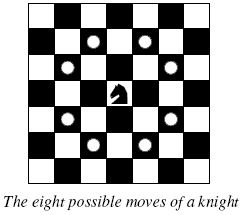|
A Knight's Journey
Description  Background
Background
The knight is getting bored of seeing the same black and white squares again and again and has decided to make a journey around the world. Whenever a knight moves, it is two squares in one direction and one square perpendicular to this. The world of a knight is the chessboard he is living on. Our knight lives on a chessboard that has a smaller area than a regular 8 * 8 board, but it is still rectangular. Can you help this adventurous knight to make travel plans? Problem Find a path such that the knight visits every square once. The knight can start and end on any square of the board. Input
The input begins with a positive integer n in the first line. The following lines contain n test cases. Each test case consists of a single line with two positive integers p and q, such that 1 <= p * q <= 26. This represents a p * q chessboard, where p describes how many different square numbers 1, . . . , p exist, q describes how many different square letters exist. These are the first q letters of the Latin alphabet: A, . . .
Output
The output for every scenario begins with a line containing "Scenario #i:", where i is the number of the scenario starting at 1. Then print a single line containing the lexicographically first path that visits all squares of the chessboard with knight moves followed by an empty line. The path should be given on a single line by concatenating the names of the visited squares. Each square name consists of a capital letter followed by a number.
If no such path exist, you should output impossible on a single line. Sample Input 3 1 1 2 3 4 3 Sample Output Scenario #1: A1 Scenario #2: impossible Scenario #3: A1B3C1A2B4C2A3B1C3A4B2C4 Source
TUD Programming Contest 2005, Darmstadt, Germany
|
提示
题意:
骑士对8*8的棋盘感到厌倦了,世界那么大他想去走走,骑士来到了一个p(行)*q(列)(1<=p*q<=26)大的棋盘,他可以以棋盘上的任何位子作为起点,给出终点,看看他能不能遍历所有的格子。(骑士的走法和中国象棋的马一样)
能遍历所有格子,输出遍历的顺序,若不唯一,先以列最小,后以行最小遍历的方式输出。
思路:
从优先列最小,最后行最小的方式枚举起点,之后DFS去搜就行了,注意输出代码的位置,我就因为这点一直想不通连样例都不能过。
示例程序
Source Code
Problem: 2488 Code Length: 1374B
Memory: 396K Time: 16MS
Language: GCC Result: Accepted
#include <stdio.h>
#include <string.h>
struct
{
int x,y;
}s[676];
int bug,v[26][26],p,q,walk[8][2]={{-1,-2},{1,-2},{-2,-1},{2,-1},{-2,1},{2,1},{-1,2},{1,2}}; //这里只需注意是以列为最小来遍历
void dfs(int x,int y,int top)
{
int i,a,b;
if(bug==1)
{
return;
}
if(top==p*q)
{
for(i=0;p*q>i;i++) //只能一有答案就输出,不然里面的数据会被替换
{
printf("%c%d",s[i].y+'A',s[i].x+1);
}
bug=1;
return;
}
for(i=0;8>i;i++)
{
a=x+walk[i][0];
b=y+walk[i][1];
if(a>=0&&a<p&&b>=0&&b<q&&v[a][b]==0)
{
v[a][b]=1;
s[top].y=b;
s[top].x=a;
dfs(a,b,top+1);
v[a][b]=0;
}
}
}
int main()
{
int n,i,i1,i2;
scanf("%d",&n);
for(i=1;n>=i;i++)
{
bug=0;
scanf("%d %d",&p,&q);
printf("Scenario #%d:\n",i);
memset(v,0,sizeof(v));
for(i1=0;q>i1;i1++)
{
for(i2=0;p>i2;i2++)
{
s[0].y=i1;
s[0].x=i2;
v[i2][i1]=1;
dfs(i2,i1,1);
if(bug==1)
{
break;
}
}
if(bug==1)
{
break;
}
}
if(bug==0)
{
printf("impossible");
}
printf("\n\n");
}
return 0;
}
























 155
155

 被折叠的 条评论
为什么被折叠?
被折叠的 条评论
为什么被折叠?








